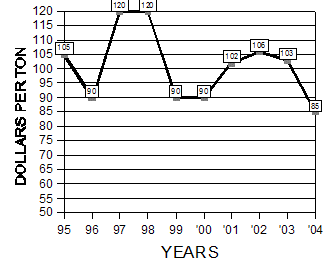Alfalfa Report
Yuma County, Arizona
January 12, 2004
Yuma County Office
2200 W. 28th Street, Ste. 102
Yuma, AZ 85364
(928) 726-3904
(928) 726-8472 FAX
Production Update:
Frost Damage: Frost injury is fairly common for alfalfa grown
in Arizona during the winter months. Leaves can be damaged by a "radiation
frost" which can occur at air temperatures above 32 F. Conversely, alfalfa
leaves can escape damage at temperatures as low as 27 F under certain
conditions. The amount of frost injury that occurs depends on several
factors. Nondormant alfalfa cultivars are more susceptible to frost damage
than more dormant cultivars. A rapid rate of temperature decline is more
damaging than a slow rate. Humidity in the air can contribute to frost
damage. A cold hardening period before the frost can lessen frost damage.
Food reserves accumulated by the plant can also lessen susceptibility
to frost.
Insect Management: Egyptian alfalfa weevil (picture)
populations buildup in hay fields during the early spring. Sample alfalfa
fields every 2 to 4 days after weevil larvae first appear. Sample each
field quadrant by taking 5 sweeps with a standard net. Count the number
of weevil larvae (
picture)
in each 5 sweep sample and add the totals for each of the field quadrants.
Divide the grand total for the field by the total number of sweeps (20).
The field should be treated with an insecticide registered for weevil
control when the average number of larvae reaches or exceeds 20 per sweep.
If sweep counts are 10 to 15 larvae per sweep just before cutting, then
applying malathion under the windrows may be considered. Avaunt is a newly
registered insecticide for alfalfa hay production that will control EAW.
Weed Control: According to L1080 forms summarized by the Arizona
Dept. of Agriculture, the most commonly used herbicide in Arizona in 2002
was Trifluralin. 55,576 acres were treated with this herbicide which was
almost twice that of any other herbicide. Second was Kerb (29,734) followed
by Pendimetanlin (Prowl, Pendimax etc.)
| Market Summary |
High
|
Low
|
Average
|
Off grade
|
| Past 2 Weeks (Dec 30 - Jan. 12, 2004) |
90
|
70
|
85
|
50-70
|
| Last Year (Dec 30 - Jan 12, 2003) |
105
|
95
|
103
|
70-90
|
10 Year Summary (Dec 30 - Jan 12, 1995-2004):

Issued in furtherance of Cooperative Extension work, acts of May 8 and June 30, 1914, in cooperation with the U.S. Department of Agriculture, James A. Christenson, Director Cooperative Extension, College of Agriculture and Life Sciences, The University of Arizona.
The University of Arizona is an equal opportunity, affirmative action institution. The University does not discriminate on the basis of race, color, religion, sex, national origin, age, disability, veteran status, or sexual orientation in its programs and activities.
Any products, services, or organizations that are
mentioned, shown, or indirectly implied in this web document do not imply
endorsement by The University of Arizona.
Information provided by:
Barry Tickes, btickes@ag.arizona.edu Extension Agent, Yuma County
Michael Ottman, mottman@ag.arizona.edu Agronomy Specialist
College of Agriculture, The University of Arizona.
Eric Natwick, etnatwick@ucdavis.edu UCCE Imperial County - Farm Advisor
University of California, Davis, CA.
Forages: Crop Mgmt | Soil Mgmt | Irrigation | Alfalfa Reports | Insects | Diseases | Weeds | Pesticides
Home | Other Crops | Forages
For more Arizona Production Ag Information:
Home | Cotton | Veggies| Forages | Grains | Citrus | Crop x Crop | Insects | Diseases| Weeds | Pesticides | News | Weather | Research | Photos | Contacts | General Info. | Site Map
Copyright © 2001 University of Arizona,
College of Agriculture and Life Sciences
Webmaster: Al Fournier (fournier@ag.arizona.edu)